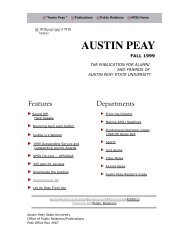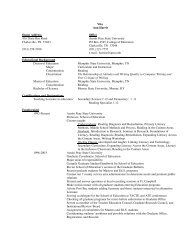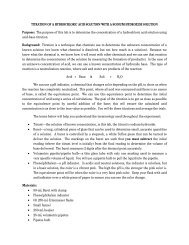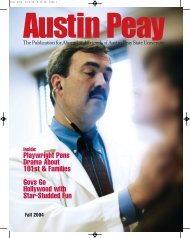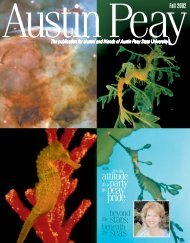fall 2004 backup 0815 205pm - Austin Peay State University
fall 2004 backup 0815 205pm - Austin Peay State University
fall 2004 backup 0815 205pm - Austin Peay State University
You also want an ePaper? Increase the reach of your titles
YUMPU automatically turns print PDFs into web optimized ePapers that Google loves.
<strong>fall</strong> 2005 9/19/05 11:02 AM Page 7<br />
eases,” he says. “We recruit absolutely the<br />
best talent for patient care, clinical research<br />
and basic scientific discovery, providing them<br />
with outstanding resources that permit them<br />
to do their best work.”<br />
Research at St. Jude—the only pediatric<br />
research hospital supported by a National<br />
Cancer Institute cancer center support grant—<br />
is unique. Rather than hiding discoveries from<br />
competitors, St. Jude scientists are eager to<br />
share them. “We know we can’t treat all the<br />
sick children in the world,” Evans says. “But<br />
we can train those who do, all over the world.”<br />
The success of St. Jude occurred because<br />
scientists there made the simple discovery<br />
that cancer treatment for children is different<br />
than for adults. “We often try to cure childhood<br />
cancers with drugs developed for quite<br />
different cancers in adults,” Evans says. “This<br />
is one reason we are working to establish new<br />
programs in chemical biology, human genetics<br />
and cancer prevention. We must ensure<br />
that our findings get translated into treatment<br />
advances for children.”<br />
Why is this St. Jude’s responsibility? It’s all<br />
about the bottom line. Large pharmaceutical<br />
companies have little interest in pediatric cancer<br />
research, because there’s no real money in<br />
it: After all, most cancers occur in adults.<br />
In contrast to drug companies, which are<br />
accountable to stockholders, St. Jude is<br />
accountable only to its mission: For St. Jude<br />
scientists and doctors, “finding cures, saving<br />
children” is the bottom line.<br />
Hope displayed in rainbow hues<br />
The corridors of St. Jude are bright with<br />
color. Murals of animals and people painted<br />
from a child’s perspective. Storybook illustrations.<br />
Each waiting area is outfitted like a<br />
playroom, complete with toys, computer<br />
games and books. Hanging in the airy atrium<br />
are scores of flags—together representing the<br />
countries of staff who left their homelands to<br />
work here. At first, a guest might think he<br />
had stumbled into Disneyland. Not so.<br />
Enthrallment with the cheerful décor disintegrates<br />
when the guide, nodding toward her<br />
right, says, “And that’s our chemo lab.” All<br />
that can be seen through a small glass panel<br />
in the door is a stroller. A blue stroller with a<br />
plaid sun cover.<br />
The earth tilts on its axis. A baby stroller?<br />
Here? This is definitely not Disneyland. This<br />
is where desperate parents bring their desperately<br />
sick children.<br />
At its soul, St. Jude is not a complex of<br />
buildings, a labyrinth of treatment rooms and<br />
labs. It is people. Doctors, nurses, scientists,<br />
technicians. Mainly, it is children—some still<br />
in strollers.<br />
Trailing clouds of glory…<br />
As director of St. Jude, Evans not only<br />
continues his own research in the Human<br />
Genome Project, he also spends increasingly<br />
more time securing support for the work of<br />
the other scientists, including his wife, Dr.<br />
Mary Relling, with whom he launched St.<br />
Jude’s first pharmacogenomics research plan<br />
20 years ago.<br />
Today, Evans and Relling lead some of the<br />
most promising pharmacogenomic studies in<br />
children with acute lymphoblastic leukemia.<br />
In the article, “Drugs by Design” in the<br />
Autumn <strong>2004</strong> edition of “Promise,” the magazine<br />
of St. Jude, Evans talks about pharmacogenomics,<br />
by which a patient’s gene code<br />
tells the doctor exactly which drug is likely to<br />
work best. This requires studies of cancer<br />
treatments in hundreds of children over<br />
decades, but St. Jude is ahead of the game.<br />
Over the years, it has collected more extensive<br />
follow-up reports on children with cancer<br />
than any hospital in the world.<br />
One of those children is Cassidie Jackson,<br />
who is profiled in “Promise.” Eight months<br />
after her birth, her parents noticed the lymph<br />
nodes in her neck felt like knots. St. Jude<br />
doctors diagnosed acute lymphoblastic<br />
leukemia, which depletes infection-fighting<br />
white blood cells. Cassidie did well during<br />
the first two rounds of chemo but, after the<br />
third round, her white blood cell count fell<br />
drastically and her stomach, liver and spleen<br />
started to swell.<br />
A genetic test revealed she had an inherited<br />
defect for a specific enzyme. This defect<br />
blocked metabolism of the anti-cancer drug,<br />
causing her body to retain high levels of the<br />
toxic drug. Thankfully, St. Jude studies also<br />
proved that patients deficient in this enzyme<br />
could benefit from a lower dose of the drug.<br />
Cassidie started taking a fourth of the dosage<br />
each time and, according to her mother, has<br />
been fine ever since.<br />
The enzyme mutations that plagued<br />
Cassidie were discovered at St. Jude, as was<br />
the genetic test now used routinely by hospitals<br />
to screen children before administering<br />
the drug. Cassidie is one of thousands of children<br />
whose tales are chapters in the amazing<br />
St. Jude Story.<br />
And thanks to such dedicated scientists as<br />
William Evans, more and more patients will<br />
live to tell their own stories. Despite the best<br />
research and treatment in the world, however,<br />
some do not make it, but their deaths are not<br />
the end. Their cancers, treatments and outcomes,<br />
their stories—all become part of<br />
research that, no doubt, will improve the odds<br />
for other sick children.<br />
The long hospital hallways are lined with<br />
scores of photos of the children of St. Jude —<br />
both the survivors and the little angels passing<br />
through. Some say to stand before these<br />
photos, to look into those eyes, is to catch a<br />
fleeting glimpse of God.<br />
<strong>Austin</strong> <strong>Peay</strong>/Fall 2005<br />
5





